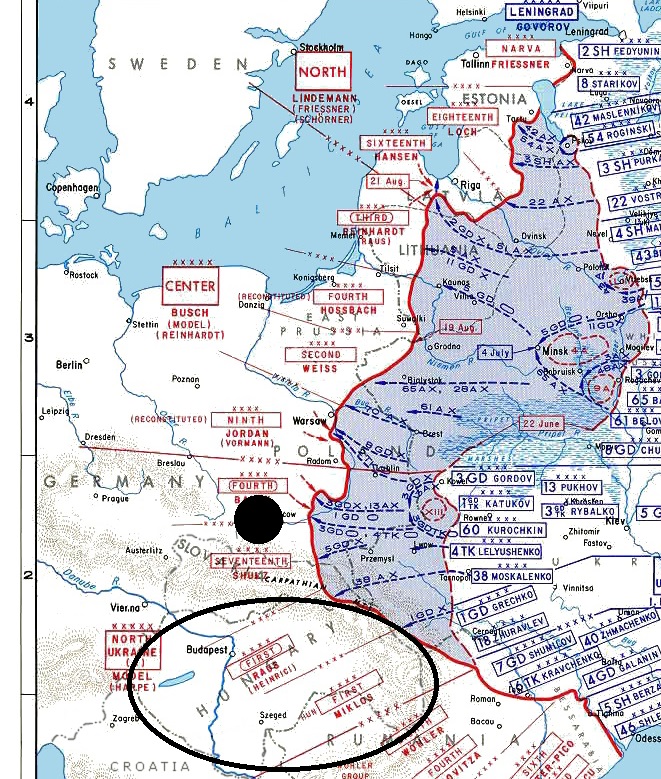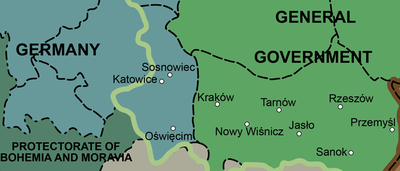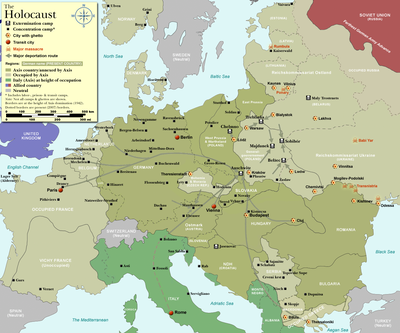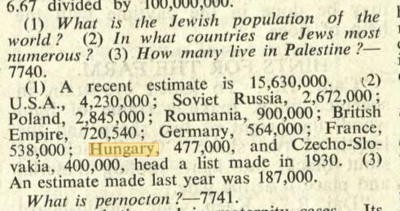Auschwitz was located in the Gau Upper Silesia, part of the Reich proper. To the East, there was the General Gouvernement, the designated Jewish reservation as described by Carlo Mattogno in chapter VIII of his book on Treblinka.
Waldgänger wrote:Government policy since 1942 had been to make sure not a single Jew remained in the Greater German Reich, to move them East as far as possible. Why would they bring in 400,000 Jews to work after having expelled almost all of their Jews in the course of the previous 2 years? It's a completely contradictory policy. If they needed hard labour for the contingencies of Total War, use the German population themselves! It was their war, after all. We can extend this to all marches of Jews out of Poland into Germany in 1945 as well. Did they really have nobody else to do their manufacturing work? Not even German citizens?
The massively expanding economy of the Third Reich demanded the use of foreign labor even before the war, totally contradicting the racial policy of the National Socialists, which was held up for some time into the war, but progressively gave way to a more pragmatic approach. You have to realize how extensive the Soviet armaments industry was (built up with American help, read e.g. Sean McMeekins book on the Soviet war). Germany was in a constant shortage of labor throughout the war and had to forcibly conscript foreigners. This was also the reason why the concentration camp system went from being administered by the
SS Reichssicherheitshauptamt (Reich security main office) to the
SS Wirtschaftsverwaltungshauptamt (Economic administration main office) after it was clear that the Blitzkrieg against the Soviet Union had failed at the end of 1941, so the concentration camp inmates could be recruited by the industry. As RODOH user Nazgul has explained, deportees weren’t exterminated, but the deportation trains simply loaded them off at each place were there was a labor camp which wasn’t necessarily a concentration camp, there were also many Jews doing forced labor outside the concentration camp system.
I quote from Mark Spoerer,
Zwangsarbeit unter dem Hakenkreuz, 2001.
The total number of foreign civilian workers, prisoners of war, and inmates deployed in the Greater German Reich in 1939-1945 is thus in the order of magnitude of a good 13.5 million; 4.6 million prisoners of war, 8.4 million civilian workers, 1.7 million concentration camp inmates, and "labor Jews," adjusted for 1.1 million double entries. Subjectively estimated, the margin of error, which mainly concerns the number of Soviet prisoners of war in labor service, is ±0.75 million. (p. 223)
This was in the Reich territory, in the occupied Soviet territories over 22 million worked for the Germans, predominantly in the agricultural sector.
Poland / General Government
Immediately after the establishment of the General Government, the government announced compulsory labor for male Jews at the end of October 1939, which it gradually extended to Jewish men and women aged 12 to 60. In the first [forced labor] camps established in 1939 and 1940, Jewish men were used for road and melioration work, especially in water management inspections. (p. 51–2)
When the Holocaust entered its decisive phase around the turn of the year 1941/42 with the liquidation of the ghettos and shortly thereafter, in the summer of 1942, the labor shortage in the Generalgouvernement became more and more urgent, the Jewish forced labor camps became even more important in the "extermination through labor". The Germans used two methods in this process, beginning in October. One was to deport all Jews - except able-bodied men between the ages of 15 and 45 - from the ghettos to the death camps and then to declare the ghettos forced labor camps.
The other was to dissolve the entire ghetto and deport the able-bodied men to separate forced labor camps. Thus, in 1942/43 there was a major expansion of the system of forced labor camps in the Generalgouvernement, the total number of which amounted to 300 to 400. The large and later notorious camps were under the control of the SS, others were under the control of the Water Management Inspectorate and the Agricultural Administration. (p. 53)
Hungary
Nevertheless, Hungary was to become an important labor reservoir toward the end of the war. Since Hungary was an ally, the Germans initially had no access to the 825,000 Jews who lived there, many of whom had been Slovak or Romanian citizens before the annexations. However, in anticipatory obedience, the Hungarian government left no doubt that it wanted to come down hard on its Jewish citizens itself. As early as 1938, it had passed discriminatory laws. In March 1939, it created a labor service for men deemed unreliable and unworthy of military service: Slovaks, Romanians, Serbs, Hungarian opposition members, but above all Jews. In principle, the birth cohorts 1894-1924 of these groups could be conscripted for labor service by the Hungarian Ministry of Defense. However, conscription was initially unsystematic, often as a result of denunciation. In the second half of 1942, under German pressure, Hungary tightened up its conscription practice considerably, so that by the end of 1942 a good 100,000 Jewish conscripts had been deployed, half in Hungary and half abroad, mainly in Ukraine. The Jews called up there had to perform hard labor in road and railroad construction as well as military entrenchment, fortification, and mine-clearing work. 10,000-20,000 died as a result of military action and the harassment of the guards, 20,000-30,000 fell into Soviet captivity, where they were treated as prisoners of war, and only about 6,000-7,000 were able to return from Ukraine to Hungary in 1943/44. Some of them and other Jewish labor servicemen, about 6,000 in all, came to work in the Serbian copper mines near Bor under an agreement between the Hungarian Ministry of Defense and the Organisation Todt in July 1943.
With signs mounting after Italy's defection and the Red Army's successful advance that Hungary might also fail as an ally, German troops occupied the country in March 1944. Under the direction of Adolf Eichmann, ghettoization began as early as April, and in May the deportation of Hungarian Jews to Auschwitz. Unlike the Jews of other regions of Europe, the Hungarians got caught up in the Nazi extermination machinery at a time when the need for manpower was even stronger than the will to exterminate the Jews indiscriminately. Thus, many of them were assigned to work on the infamous ramp at Auschwitz. Several tens of thousands of Hungarian Jews, including many girls and women, escaped immediate extermination in this way. They worked primarily in the factories of the aircraft industry, whose representatives were desperately waiting for the Hungarian concentration camp prisoners in the spring of 1944.
The Jewish labor servants were initially spared the deportations. International pressure grew on Hungary not to extradite any more Jews to the Reich. The Hungarian Ministry of Defense, of all people, which until then had contributed significantly to the merciless living conditions, now hastened to conscript the remaining Jewish men of the relevant birth cohorts in order to save them from the German deportations. Jewish women between the ages of 18 and 30 were also conscripted into service, increasing the number of Jewish labor conscripts much to the annoyance of the Germans. At the beginning of July, the Hungarian Reichsverweser Milós Horhy prohibited all further deportations from his country. By this time, all 200,000 Jews still remaining in Hungary who were not in one of the labor companies were in Budapest. Just a short time before, in June, about 15,000 Hungarian Jews had been taken to a camp in Straßhof, northeast of Vienna, 40% of them women. They were "exchange Jews" who were to be spared the Holocaust for the time being in exchange for supplies from abroad that were essential to the war effort. From Straßhof they were distributed to the Gaue Vienna and Niederdonau for forced labor and, unlike all other prisoner groups, were used on a large scale in agriculture.
In September, the Hungarian government announced general compulsory service for all Jews between the ages of 14 and 70. Plans to arm them and declare Hungary neutral were thwarted. The Germans forced Horthy to abdicate in October and installed a puppet government, which immediately thereafter carried out massacres of Budapest Jews and, despite strong international protests, prepared to extradite the remaining Jews to the Germans. In several treks, Hungarian units drove the Jewish labor servants and part of the Jews remaining in Budapest westward toward Vienna in forced marches in early November - the Red Army had already reached suburbs of Budapest. Of the 70,000, only about 40,000, including almost 10% women, reached the Hungarian-German border and were handed over as "exchange Jews" to the SS, who had them do construction and entrenchment work under murderous conditions. Both the "exchange Jews" and the "loaner Jews" initially worked outside the concentration camp system, although the SS provided the guards. In March 1945, the SS drove the surviving "loaner Jews" toward the Mauthausen concentration camp. It is unknown how many Hungarian Jews in total were forced to perform forced labor for Germany. 440,000 were deported to Auschwitz, and about 55,000 reached the former Austro-Hungarian border as "exchange" or "loan" Jews. Of these almost 500,000 deportees, only 116,500 returned to Hungary from the German concentration camps or concentration camp-like camps in Austria by the end of 1945. (pp. 84–6)









